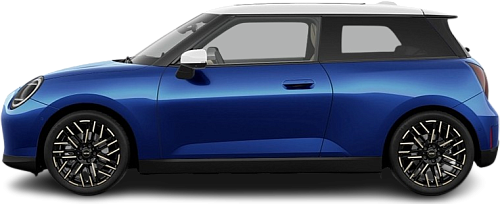USA EV Comparison: Honda Fit EV Gen 1 vs Mini Cooper SE
Struggling to Decide? Let AI Help!
Your AI Summary Is Ready!
General Info
The Mini Cooper SE (2023-…) is currently produced, it has a starting price of $31895. The Honda Fit EV (2013-2015) has been discontinued. You can find it for as low as $4100 on the used car market.
The two vehicles share the same body style: Hatchback.
| Property | Honda Fit EV Gen 1 | Mini Cooper SE |
|---|---|---|
| Years of Production | 2013-2015 | 2023-… |
| Current Status | Discontinued | Produced |
| Country of Manufacture | USA | China |
| Body Style | Hatchback | Hatchback |
| Market Availability | USA | EU, USA |
| Price USA (New) | - Price USA (New) | $31895 |
| Price USA (Used) | $4100 | $22420 |
| GCC Score | 3.9 | 5.1 |
Range and Efficiency
While the Mini Cooper SE (2023-…) offers a longer real-world range and a bigger battery, it is less energy-efficient than the Honda Fit EV (2013-2015).
| Property | Honda Fit EV Gen 1 | Mini Cooper SE |
|---|---|---|
| Range (EPA) | 82 mi | 114 mi |
| Range (WLTP) | - Range (WLTP) | 250 mi |
| Range (GCC) | 78 mi | 179 mi |
| Battery Capacity (Nominal) | 20 kWh | 54.2 kWh |
| Battery Capacity (Usable) | 19 kWh | 49.2 kWh |
| Efficiency per 100 mi | 24.4 kWh/100 mi | 27.5 kWh/100 mi |
| Efficiency per kWh | 4.11 mi/kWh | 3.64 mi/kWh |
| Range and Efficiency Score | 5.4 | 5.7 |
Charging
Both vehicles utilize a standard 400-volt architecture.
The Honda Fit EV (2013-2015) has no DC fast charging capability, whereas the Mini Cooper SE (2023-…) can charge at up to 95 kW.
The Mini Cooper SE (2023-…) features a more powerful on-board charger, supporting a maximum AC charging power of 7.4 kW, whereas the Honda Fit EV (2013-2015) is limited to 6.6 kW.
| Property | Honda Fit EV Gen 1 | Mini Cooper SE |
|---|---|---|
| Max Charging Power (AC) | 6.6 kW | 7.4 kW |
| Max Charging Power (DC) | - Max Charging Power (DC) | 95 kW |
| Architecture | 400 V | 400 V |
| Charge Port | Type 1 (J1772) | CCS Type 1 |
| Charging Score | 2.7 | 4.9 |
Performance
Both vehicles are front-wheel drive.
The Mini Cooper SE (2023-…) boasts greater motor power and accelerates faster from 0 to 60 mph.
| Property | Honda Fit EV Gen 1 | Mini Cooper SE |
|---|---|---|
| Drive Type | FWD | FWD |
| Motor Type | PMSM | PMSM |
| Motor Power (kW) | 92 kW | 160 kW |
| Motor Power (hp) | 123 hp | 215 hp |
| Motor Torque | 189 lb-ft | 243 lb-ft |
| 0-60 mph | 8.1 s | 6.9 s |
| Top Speed | 90 mph | 106 mph |
| Performance Score | 2.7 | 3.9 |
Dimensions
Both models have similar wheelbase lengths.
| Property | Honda Fit EV Gen 1 | Mini Cooper SE |
|---|---|---|
| Length | 161.6 in | 151.9 in |
| Width (with Mirrors) | 66.7 in | 77.4 in |
| Width (w/o Mirrors) | - Width (w/o Mirrors) | 69.1 in |
| Height | 60 in | 57.5 in |
| Wheelbase | 98.4 in | 99.4 in |
Cargo and Towing
Neither car is equipped with a frunk (front trunk).
Neither vehicle is officially rated for towing in the US.
| Property | Honda Fit EV Gen 1 | Mini Cooper SE |
|---|---|---|
| Number of Seats | 5 | 4 |
| Curb Weight | 3252 lb | 3527 lb |
| Cargo Volume (Trunk) | 12 ft3 | 7.1 ft3 |
| Cargo Volume (Max) | - Cargo Volume (Max) | 28.3 ft3 |
| Cargo Volume (Frunk) | - Cargo Volume (Frunk) | - Cargo Volume (Frunk) |
| Towing Capacity | - Towing Capacity | - Towing Capacity |
| Cargo and Towing Score | 4 | 3.6 |




